Identity and the Museum Visitor Experience
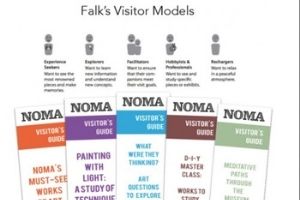
Intern Weekly Response
Every week we’re asking our summer interns to share some thoughts and responses to various experiences and readings. This week we asked them to read one of two chapters from John Falk’s Identiy and the Museum Visitor Experience and write a short response piece! To read more posts from JMM interns, past and present, click here.
The Museum Visitor Experience Model: Conflicting Identities
By Collections Intern Amy Swartz
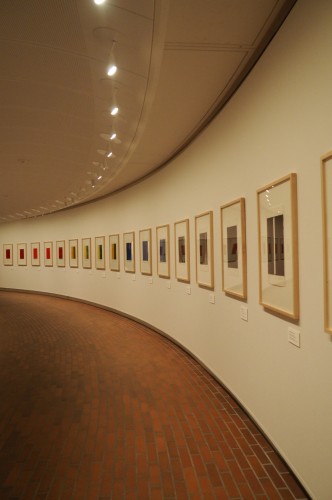
John H. Falk’s Identity and the Museum Visitor Experience’s 7th chapter explores types of museum visitors and how their identities affect their museum experience. There are five main identities related to motivation. They are: Explorer, Facilitator, Experience seeker, Professional/Hobbyist, and Recharger. Reflecting back on the reading and my own museum experiences, I have found that these identities are usually inter-changeable and dependent on the context of one’s visit. I usually fall into the category of explorer, or someone who goes to a museum open to wandering and looking through the exhibit in their own way at their own pace. Every museum I visit, whether it is one I have been to before or not, I inhabit that character.
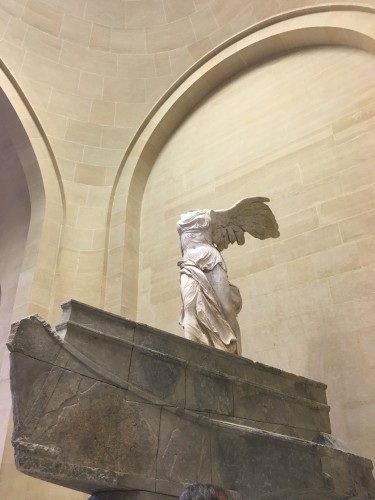
However, while I studied abroad, museums were one of the go-to places to visit in each city. Due to time constraints and the likelihood that I would not be visiting again very soon, I fell into the Experience-seeker identity. I sought out the “best” or most well-known parts of museums to not only see them but to check them off my bucket list. In particular, my visit to the Louvre was motivated by this identity. Although I could spend days looking through the Louvre, my friend and I could only spend a certain amount of time in the massive museum so we headed towards some of the “greats” including the Venus de Milo, the Mona Lisa, and my favorite, the Nike of Samothrace. Sometimes I also inhabit the facilitator category when I bring my friends with me to museums more so that they could learn more about my favorite subject rather than for me. Ultimately, I found these motivational identities to dependent on multiple factors.
Using the Museum Visitor Experience Model as a Visitor
By Exhibitions Intern Tirza Ochrach-Konradi
This chapter introduces us to the five types of museum visitors: explorers, facilitators, experience seekers, professionals, and rechargers. These categories are useful both in the way they are intended to be used, as metrics for museum staff to better understand their patrons, but are also a great tool for museum goers to better plan to meet their own needs. For example, if someone realizes that they primarily go to museums to recharge, it would beneficial for them to inquire by phone which hours the museum is free of school groups or has the lowest attendance. This will help them pinpoint the time where they can best enjoy the museum the way they would like to without being interrupted.
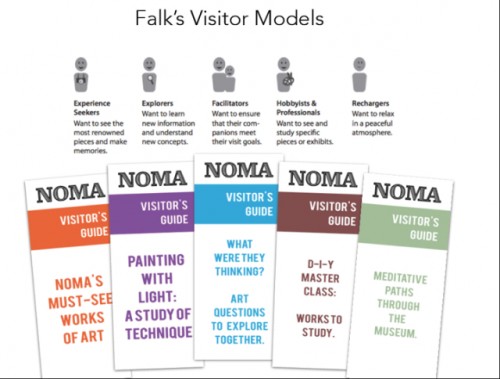
For myself, I am generally a member of the most common category, the explorers. In the future, if I want to maximize my personal enjoyment of a museum it would be smart if I did some planning before I went. As an explorer, I am most going to enjoy seeing exhibits on a topic of which I already have prior knowledge. Before I attend a museum it would be smart if I checked the existing exhibitions online before I visited. I will likely figure out what exhibitions I am most interested in seeing and be able to make a plan about how to do that. I can also choose to do research about an exhibition topic that I am unfamiliar with, which would make that particular exhibit more interesting for me. I would be much more likely to walk through the exhibit if I knew something about its contents than if I went to the museum with no knowledge of the topic. By doing a little extra work beforehand, my museum trip can be more fruitful. Not only is it important that museum staff consider visitor’s motives it is also empowering if visitor’s can pinpoint for themselves what kind of visitor they will be and take steps to ease their own museum experience.

The Five Visitors You’ll Meet in a Museum
By Education Intern Erin Penn
I really enjoyed learning about the different types of visitors that come to museums. The article explains there are five types: explorer, facilitator, experience seeker, professional/hobbyist, and recharger. As the chapter outlined the various visitors, I grew a deeper appreciation and understanding of the wide audience of this museum.
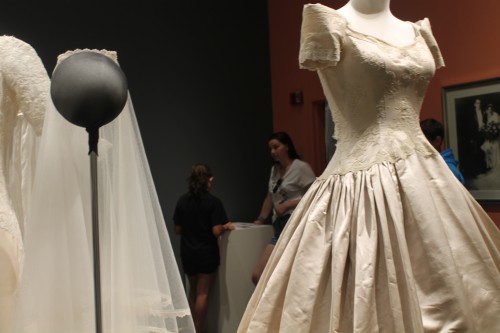
In my job in the education department, I have to work to create activities for all kinds of visitors. The scavenger hunt for Just Married, Sara and I created, had to consider how each student was going to approach the exhibit. Now seeing several classes use the scavenger hunt, I see how some students have different ideas of a museum and how to approach a challenge. Some students were such explorers; they chose not even to complete the scavenger hunt but to play with the meeples. It was neat to connect the reading to my firsthand experience as an education intern.
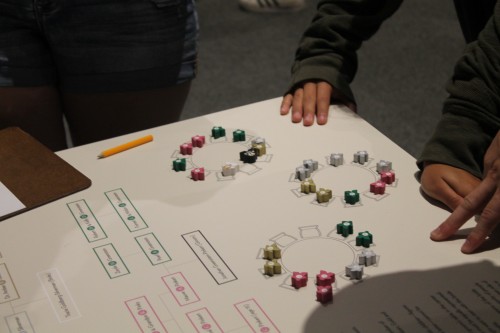
What Type of Museum Visitor are you?
By Collections Intern Joelle Paull

Museums are places of learning, new experiences, and discovery. We have different reasons for visiting and all experience museums differently. In his book Identity and the Museum Visitor Experience, John Falk describes five different types of museum visitor. Take this quiz to determine which type of visitor you are.
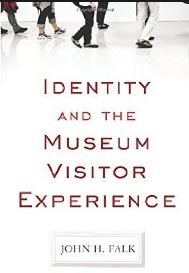
Quiz:
1. Why do you go to museums?
A — To see everything I can and learn as much as possible.
B — To share experience/knowledge with family or friends.
C — To see famous works of art and objects or to seek out new experiences.
D — To gain knowledge and further my preexisting knowledge of the subject.
E — To relax after a long work week.
2. How to you go through a museum?
A — Look for things that interest me and gravitate towards those things.
B — Find things I can share with my family or friends that would interest them.
C — Try to see everything I can, scanning galleries and labels for important information.
D — To accomplish preset goals.
E — Sit down and spend my time experiencing the galleries and objects.
3. How do you react to a crowded museum?
A — Ignore the crowds and continue to explore.
B — Make sure everyone in my group stays together.
C — Join in on the fun! I want to be where the crowds are.
D — Come back another time when it is less crowded.
E — Retreat to the gift shop or cafe.
4. How do you feel after you leave the museum?
A — I have learned something new.
B — My family or friends learned something new and had a shared experience.
C — I have experienced something unique and want to pursue more experiences.
D — I want to keep learning about the subject — through books, lectures, etc.
E — Relaxed and ready to take on the week.
Results:
Which letter did you have more of?
A — Explore: You have no set goals when entering a museum. You want to explore and discover things that interest you. Falk makes the analogy between explores and shoppers who love to browse without a specific item in mind. You read labels and take your time in exhibits.
B — Facilitator: You are a parent, friend, school teacher etc. facilitating the museum going experience of others. You act as a sort of tour guide through the museum.
C — Experience seeker: You visit museums in search of new and exciting experiences, often choosing to focus your time and energy on the museum’s highlights rather than looking at everything. You like taking photos in museums and enjoy interactive exhibits.
D — Professional/Hobbyist: You know about the subject matter in the museum. You are focused on learning more about it or finding answers to your questions. You tend to have an idea of what you want to see before you enter the museum and know how best to get there.
E — Recharger: You seek out museums as a relaxing leisure activity. You pay attention to the design of the gallery spaces. You often will sit down and take your time in galleries. You may not always read all the labels but will spend a lot of time looking at the object on display. After visiting the galleries or as a break you may peruse the gift shop or grab a bite to eat at the museum’s cafe.
Putting Museum Theory Into Practice
By Education Intern Sara Philippe
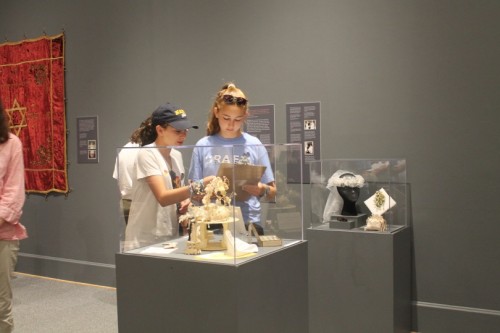
Chapter 10 of Identity and the Museum Visitor Experience, “Making Museums Work for Visitors” describes five different kinds of museum visitors – explorers, experience seekers, facilitators, rechargers, and professionals/hobbyists. Reading this article has made me reflect on the specific needs of the people I observe visiting the JMM and to compare it to the work the museum does to attempt to meet the varying needs of all these types of visitors. Yesterday, several groups of middle/high school-aged students visited the museum and participated in the scavenger hunt Erin and I created for the Just Married! exhibit. However, two of the groups did not have the time to use the scavenger hunt, instead touring the exhibit freely, which provided me with an opportunity to think about how the work a museum does to shape the visitor’s experience can have a big impact on the level of information the visitor absorbs.
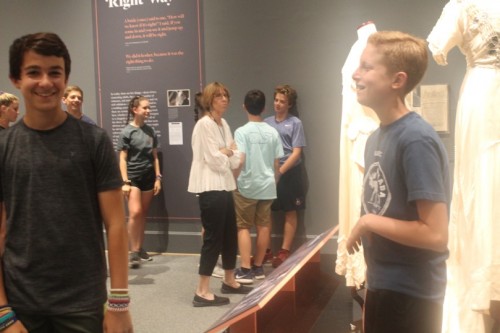
While the scavenger hunt helped generate enthusiasm in regards to the exhibit and made the campers responsible for learning and reporting on new information, without the scavenger hunt, it was easy for them to miss important, interesting information. I saw how, in this way, the scavenger hunt served as a facilitator parent of sorts, guiding the students in the effort to provide them with the best experience possible. The campers, on the other hand, were experience seekers, interested in enjoying the exhibit and seeing its highlights. Because experience seekers are not detail-oriented and prone to reading every label, the scavenger hunt offered them the opportunity to be guided to some of the most fun and compelling aspects of the exhibit.
Childhood Experiences Turned Into Repeated Visits
By Exhibitions Intern Ryan Mercado
I credit my public education in Montgomery County, MD and its proximity to the array of museums on the National Mall as the reason for my interest in museums. Every summer I, or my family always take a trip to the National Mall to visit museums, sometimes ones that we’ve gone to many times before. This week I was assigned to read “Making Museums Work for Visitors,” in Identity and the Museum Visitor Experience. This chapter is all about why people go to Museums, what characteristics of exhibits and museum buildings make it easier for people to come, and what they get out of their visits. What really resonated with me are the reasons the article cited as to why people choose to come back to museums and exhibits which they have already seen. The answer the article gave is personal context. This personal context rings true for me. As stated in the beginning of this post, I always go to the National Mall every summer to visit museums I have seen at least 10 times before. Why? Because of personal context.

There are two exhibits in particular that I will probably never get tired of going to. They are the Hope Diamond Exhibit in the Smithsonian Museum of Natural History, and the Peacock Room in the Freer Gallery of Japanese Art. For some reason, I always go straight to those exhibits when I enter those Museums. Sometimes if I’m in the city not on a “museum crawl”, I’ll peek in to get a look at the Peacock Room at the Freer because its right next to a metro station. Why do I love these exhibits when there are better exhibits to see? Personal context is the answer! I remember when I was in elementary school that we had a whole unit on gems. So naturally, my class took a trip to the Museum of Natural History. As we entered the gem exhibit, the first item I saw was an elegant blue gem in a diamond necklace. It was in a special glass case in its own separate room. People crowded around it just to get a glimpse of it. I pushed my way through and saw this beauty with my own eyes. It was the Hope Diamond, the most famous gem in the world. I was amazed at its beauty and history, so much so I bought a mock one from the gift shop that day. Now, because of that initial visit, I always go see the Hope Diamond whenever I go to the Natural History Museum.

The second place, the Peacock Room is located in the Freer Gallery of Art. When I was little, my family was on a museum crawl. ALL of the Museums were packed, except for the Freer, which just acquired a new exhibit, a room from a house that featured elegant Asian art. We wanted to see this new exhibit and headed on over. It is called the Peacock Room, a masterpiece by American artist James McNeil Whistler. Its green and gold designs amazed me by its attention to detail. And this is coming from someone that doesn’t really know much about art history. Like the Hope Diamond, it stuck in my head, which is why I always go see it. So in a sense, the museum visitor experience is important especially to young children, something as small as a blue gem or large as a painted room can leave someone amazed and keep them coming back. Personal experience is key!

1 reply on “Identity and the Museum Visitor Experience”
Really like the quiz on what kind of museum goer I am. It turns out that I am an “A” Explorer. So true. How did they know? I also enjoyed the photographs attached to the above articles. Especially the wedding dress. I really appreciate the writers because I am not a writer and enjoy reader very short works. Take care and enjoy your time to relax at a museum.